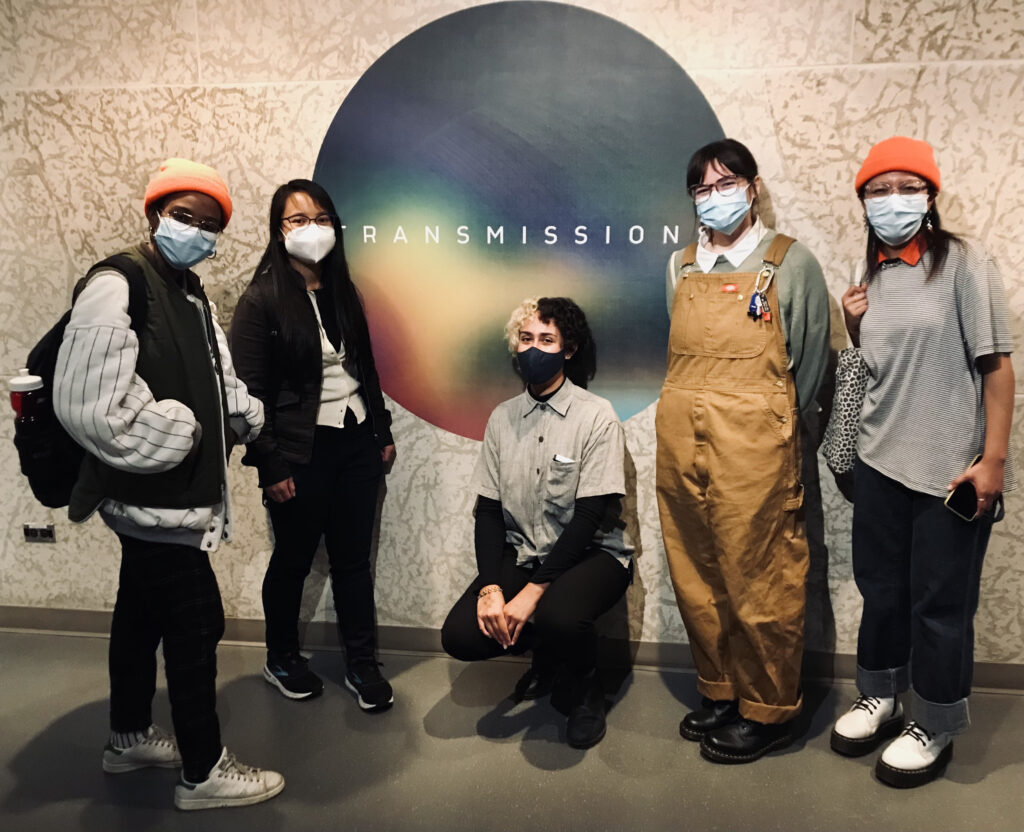
On September 22, 2022, Museum Queeries members visited the Winnipeg Art Gallery for a guided tour of Transmissions with curator Mariana Muñoz Gomez. Transmissions is an exhibition exploring the production and passing on of knowledge through embodied processes. Read more about it here.
“What a wonderful tour! Walking through this exhibit with the rest of my MQ colleagues felt like a nice change of pace compared to our previous group tours. In all our museum tours, it’s almost an instinctive reaction to be critical the moment we step into any exhibit. For this tour, however, Mariana Muñoz Gomez—the exhibit curator and our tour guide for the day—encouraged us not to intellectualize what we saw and instead to be aware of our emotions as we viewed the various artworks. With this encouragement, I tried my best not to explain the art to myself but to feel it instead. I remember almost feeling the texture of imprinted beads on Jeneen Frei Njootli’s skin upon seeing their installation and the feel of goosebumps in response to its accompanying audio of wallpaper ripping. I remember being sucked into Gonzalo Reyes Rodríguez’s documentary and feeling that familiar hunger of wanting to know the lives of strangers. Mostly, though, I remember having to remind myself to call my grandmother after seeing the paintings of Peter Banksland, Elsie Klengenberg, and Norval Morriseau. This collective practice of feeling instead of reasoning opened up a new way of touring with MQ that I’ve never done before, and it is something I hope to do with the group more often!” – Mika Castro
“The exhibition titled Transmissions by Mariana Muñoz Gomez at the Winnipeg Art Gallery was an exploration of embodiment, a topic that I had not thought about intentionally but was excited to understand more through Gomez’s lens of curation. The artists in the exhibition all bring their own interpretations of embodied practice that stem from questions of the self, their relationships to others, and past histories to think about how embodiment has come to be. In particular, the work of Gonzalo Reyes Rodríguez struck out to me because of the photographs, which he stumbled upon while browsing at the thrift store, that are remixed with his own personal photos. The assumptions that are brought onto those were very interesting to me, since the artist proposes the potentiality of the person in the photos being queer. The act of queering a photo, when there are gestures, poses, clothing, and gazes that could be perceived as queer or tied to a queer body, works as a tool to create a queer archive and to bring life to something that maybe would not have existed as such without it.” – Mahlet Cuff
“Transmissions is a must-see. Curator-in-residence Mariana Muñoz Gomez’s phenomenal exhibit explores and reveals the different dimensions of ‘embodied knowledge.’ Embodied knowledge, which refers to the emotional, experiential knowledge we all hold, can be determined by positionality and one’s community formation. To evaluate embodied knowledge on this scale is to shift importance away from systems of knowledge (such as the academic institution) managed and necessitated by Western, colonial powers. I felt so glad to visit this exhibit with my Museum Queeries colleagues. It was a pleasure to learn about the various artworks and how each work distinctively responds to the theme of embodied knowledge.” – Niamh Griffin
“I was really captivated by this exhibit, and as much by the tour that curator Mariana Muñoz Gomez led for us. The works by contemporary artists Jeneen Frei Njootli and Preston Pavlis stood out to me in particular for the intimate and powerful ways that they conveyed knowledge transmission through the medium of skin. The curator referred to these works as representations of “embodied knowing,” and I was left thinking about what skin can teach us through its dual ability to cover and expose. Skin appears (and disappears) in museums and galleries in many ways. What happens when we pay attention to or encounter skin in these contexts? What can we learn?” – Angela Failler
